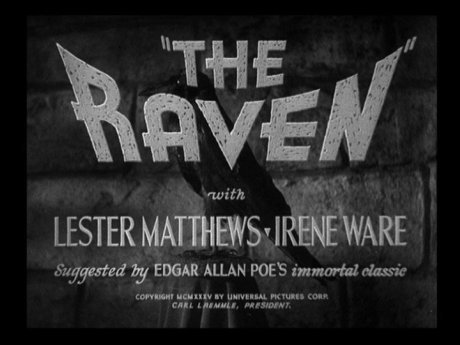


The Raven was Universal Film’s third and final excursion of the 1930s into the works of Edgar Allan Poe. Like The Black Cat (1934), the link between Poe’s work and the end film is minimal – indeed as is a common device in most Poe films, the works of the writer are slotted in by making the main character a Poe fan.
As well as being thematically similar to the earlier Black Cat, The Raven shares most of its plot flaws. Lugosi and Karloff share top billing, and together account for most of the screen time and characterisation; but the Thatcher family, who are the ‘good-guys’, get almost no character at all, especially Jean’s fiancée who should be the hero of the piece; by the end we are rooting for Voller not Thatcher. The sudden arrival of a random mix of characters at the party Voller organises, come out of nowhere, with no mention of them previously, or of who invited them - they also add a little needed comic relief that damages the horrific atmosphere. The film’s pacing is slow, and although the climax is strong and tense the ending is far too sudden and very poor. On a positive note, the film does have a few good sequences – hearing Lugosi recite part of the original Poe poem is a treat; while Bateman’s awakening after the surgery, as he sees himself in the mirrors, looks straight out of a Frankenstein film and is acted well.
The film’s direction is mediocre, Lew
Landers is little more than a studio hack, and with the exception of
one nice tracking shot along a corridor, does nothing to bring out
the dramatic gothic sets and torture chamber. The set design is
decent although does not compare to the magnificence of the early
Universal horrors, or the hellish art-deco designs of The Black
Cat.
Karloff's hideous make-up, from the expert Jack Pierce, looks okay in
long shot, but suffers under the frequent close-ups. The music is a
standard Universal affair, with the usual hints of Bach's Toccata and Fugue in D Minor.

Bela Lugosi is on usual form as the creepy doctor, his line readings are as good as ever and he even pulls off a manic laugh without looking cliché; despite the film, he is on good form here. Karloff gets a lesser role, and spends much of the film with half his face plastered over, but unlike his famous Frankenstein (1931) portrayal he gets little chance to display any range – only the sequence when he awakens after surgery allow him any chance to act. Samuel Hinds as Judge Thatcher is pretty unimpressive, and it is a pity that Edward Van Sloan was not used in a part that would have suited him. The remainder of the cast fade into the background, none given a big enough part.
Ultimately, The Raven suffers from the same fate as The Black Cat (1934) with Lugosi and Karloff given most of the storytime, and no build up of the supposed good-guys. While the earlier film at least looked pretty good, Lander’s direction here does nothing to bring out the gothic potential in the house or settings, or build up much tension. Bela Lugosi’s performance is the only thing that saves the film from being completely forgettable, even Karloff suffers in an underwritten role. Recommended only to Lugosi fans or Universal completists.

| Anyone famous in it? | Bela Lugosi - the most famous Hungarian export, best known for his leading role in Dracula (1931) Boris Karloff - a legend of horror cinema, and best known for his defining role in Frankenstein (1931) |
| Directed by anyone interesting? | Lew Landers (credited as Louis Friedlander), a studio director who never progressed above the B-movie. |
| Any gore? | None. |
| Any sex? | None. |
| Who is it for? |
Bela Lugosi fans will want to watch this, but even by Universal horror standards, it is pretty poor. |
| Good soundtrack? | Standard orchestral score. |
| Visuals | Original Aspect Ratio - 1.33:1 fullscreen. Black and White. The print quality is okay, frequent speckles and scratches but never unwatchable. Not as good as some of Universal's other releases, but far superior to any public domain prints. |
| Audio | English language original mono sound. Very strong and clear. |
| Subtitles | English HOH, French and Spanish. |
| Run-time | Feature: 1hr 01m 08s |
| Extras | None. |
| Availability | Only avaliable in The Bela Lugosi Collection boxset. |
| Region | Region 1 (USA) - NTSC |
| Other regions? | Cheap R4 Australian release, lower quality. |
| Cuts? | None known. |